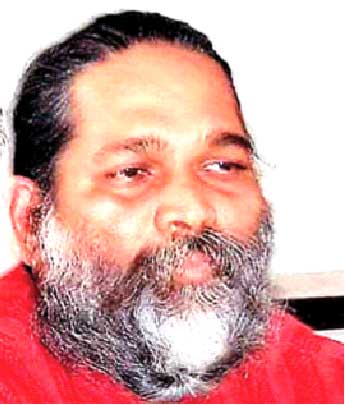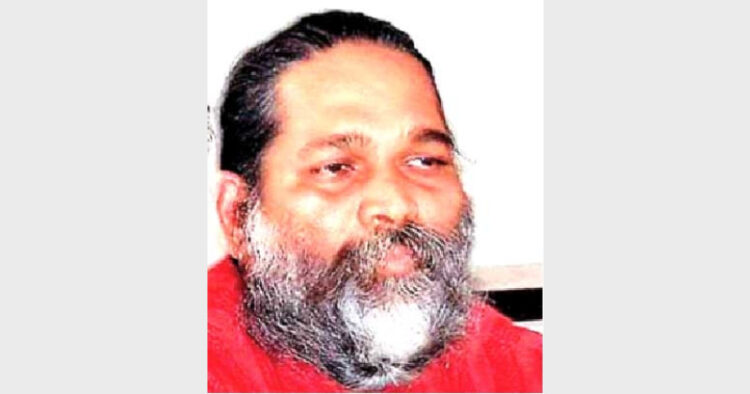Ajay Bhardwaj
 A stone is not a stone the way we take it. It has a life force in it which connects to the Supreme power. A sculptor simply chisels that out. In the process, sometimes he bleeds too. But before he gets into the act, he has to feel the stone, its life force and completely surrender to it This is how, Adwaita Gadanayak, Director General of the National Gallery of Modern Art, feels about the Bharatiya sculture.
A stone is not a stone the way we take it. It has a life force in it which connects to the Supreme power. A sculptor simply chisels that out. In the process, sometimes he bleeds too. But before he gets into the act, he has to feel the stone, its life force and completely surrender to it This is how, Adwaita Gadanayak, Director General of the National Gallery of Modern Art, feels about the Bharatiya sculture.
Winner of the Lalit Kala Akademi award, Adwaita, a sculptor of international repute, has also been head of the School of Sculpture at the Kalinga Institute of Industrial Technology.
A stone, to him, being our oldest family member in the universe, knows it all. It is as much a living being as humans are. That is why in Mecca people can relate to the rock in a similar manner as they do with the wall of Jerusalem. The Vivekananda Rock Memorial symbolises this as much as the rock pillar in the Jagannath temple does.
Why has this philosophy among sculptors taken a back seat today? What is the crisis in the Bharatiya world of art and how can it be addressed?
In a free-wheeling interview Adwaita shares his mind with Organiser ;
Excerpts; .
How do you look at ancient art heritage of Bharat?
We have a very rich art heritage that we see mostly in our temples and also in far-flung villages where, traditionally, art has been a way of life. One outstanding aspect of art in the ancient times has been that it made a connect with the Supreme power or the Almighty. Whatever was done artistically it was done to help the viewer or the participant build a connect with the God or the cosmos. Our art was collective and sometimes it n
How do you look at ancient art heritage of Bharat?
We have a very rich art heritage that we see mostly in our temples and also in far-flung villages where, traditionally, art has been a way of life. One outstanding aspect of art in the ancient times has been that it made a connect with the Supreme power or the Almighty. Whatever was done artistically, it was done to help the viewer or the participant build a connect with God or the cosmos. Our art was collective and sometimes it even involved generations. But it always had a touch of spirituality. That was the cardinal principle.
Why don”t we find it
happening anymore?
Basically you see it all disappeared as soon as invaders started destroying our temples and spread terror. After the invasions the temple art simply vanished from the public, and whatever art was left, it was in far-flung villages where traditional artists kept it alive stealthily. In Odisha, for example, you don’t see any art after the 13th century when the Muslims invaders started spelling terror. Similar has been the fate of other states as well.
How do you assess the art that flourished during the Muslim and the British periods in Bharat?
We see the stamp of the Muslim art mostly on the forts that they built, besides, of course, the work of artisans. One sees a distinct Persian influence in that. We find its influence mostly on the painting schools. The British also demonstrated it largely through the architecture which sometimes had a Gothic touch.
In painting and sculpture we clearly see western influence mainly because mostly our artists pick up their lessons from the West. They have their training in lines with the western artists. For them it becomes art for art’s sake, very individualistic. For example, they would first see pain somewhere, then would try to reflect it in their piece of art. They would first search for a theme , then translate it into art. The Bharatiya way is different. We do not harp of personal agony and pain. For us art is collective and is for the society. It is a collective effort like a wedding in the village where everybody is contributing his or her bit and it becomes a celebration for the entire village. It is not just confined to a particular family. Similarly, our art is meant for the society. It elevates us all to higher planes. It is not simple catharsis. It is a spiritual experience.
Did the Muslim and the British influence our core Bharatiya art or do you see any
convergence of the three streams ?
Not really, though it just co-existed. In the normal scheme of things artists should have imbibed the present stream of their respective period, but I don’t see it happening. Moreover, unlike their art, which was more demonstrative and exhibitionist, our art had a soul to it. As I said earlier it was a connect with the Supreme. It was a spiritual experience altogether.
What is peculiar about Bharatiya art?
The whole lot of craft that is popular particularly in tribal areas needs to be revisited. It is so unfortunate that the tribal art was categorised as a craft by the British and was left to fend for itself as an inferior art. We need to restore respect and dignity to it. And it is not easy. We tried it in Odisha when quite a few craftsmen were brought from their villages, given an accommodation in an urban area, provided with all facilities to replicate what they would do in their villages. But much to our surprise they all left one by one. Nobody felt pampered with the hospitality we provided. They wanted to go back to their places where they would feel the nature, where they would relate to the birds and nature because that was their source of creativity. In the town they felt suffocated in spite of all the facilities.
We need to bring that “light” to the new generation of artists to help them have a feel of the roots.
Moreover, we need to build a link between the art and the society.Today, the art has become decorative. You cannot touch a piece of art, you cannot feel a piece of art. You can just purchase an art work of a reputed artist, display it in your living room and feel contented. This is not what art is meant for. You should be abel to feel the art, and get elevated with the creation. My grandmother would touch my body and would find out if I was keeping fine, if I was well. Touch is so important.
Do you think we have lost our art now?
No no. We have not lost it, nor has it become extinct. It has gone into a long hibernation. We just need to retrieve it from its sleeping state.
Wha do you think has been ailing our art world ?
The major problem is that the education system has westernised our perceptions. We are in a mad race to accumulate..money, get a vehicle, a house etc. These are the ambitions. To me it seems we are a lost generation completely.
What should be done to set it right ?
We need to go back to the nature and generate poisitive energy.. An artist derives from the Nature and gives it back to the Nature. Our cities have lot of negative energy, hence our art works come out of the negative energy. We need to go back to our roots. Rediscover ourselves, the way our forefathers would do in the lap of the nature. The link between art and society must be re-established. The art should not just be confined to drawing rooms but should become part of the day to day life.
We need to project our art to the world. So far we have the art that the West imposed on us. We started looking at the art with western eyes, hence lost the core of Bharatiya art. It is gasping for breath in far-flung areas. We need to bring it back to the centre stage. In fact, we need to launch a global art movement to project the Bharatiya facet of it.
Another important change that we need to bring about is to restore respect to the Art Teachers. Normally, in schools and colleges, they are treated as second-grade teachers
How can we revive our ancient art and heritage which you see is exclusively ours in many ways?
We need to reconnect to the roots. Find out where its remnants are and try to get them back to the mainstream. A lot of research is required for that, something like Dr BN Goswamy, an acclaimed art critic, has done by rediscovering painting school of Nainsukh of Guler. We need to undertake similar exercise on a large scale.













Comments